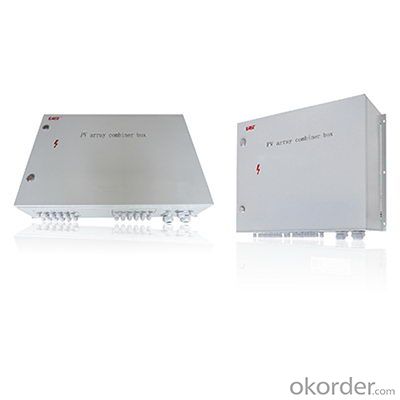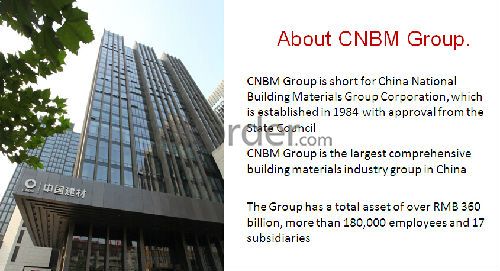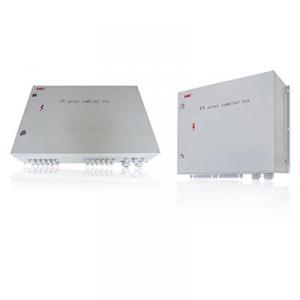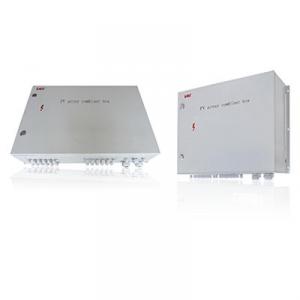ON-GRID PV - Combiner Box Maintain Easily, and Improve Reliability
- Loading Port:
- China main port
- Payment Terms:
- TT or LC
- Min Order Qty:
- 10 carton
- Supply Capability:
- 20000 carton/month
OKorder Service Pledge
OKorder Financial Service
You Might Also Like
EAPVCB-08/16/18S
To reduce the connection cables between the PV modules and solar inverters, to maintain easily, and improve reliability, in the large-scale photovoltaic power plants of on grid system, it’s necessary to use DC combining device between PV modules and solar inverters. EAPVCB Series PV array combiner box is specifically designed for high performance and high reliability, working with the PV inverter products from East Power to form complete photovoltaic system solutions. With PV array combiner box, and based on the PV inverter input voltage range, users can use certain numbers of PV panels with same specification in serially to form a PV module and connect several PV modules into the combiner box, and going through the SPD and breaker to output, which makes it easier to connect with inverter and also reduced the system installation time.
● Water protection level is IP65 for outdoor installation
● Wide range of DC input voltage (Max input open voltage can be up to 1000V)
● Dedicated photovoltaic fuses are used in each input,can bear DC1000V,fuse current can be selected
● Each input fuse is with a fuse holder, easy to replace and repair.
● Special high-voltage PV SPD is used,both positive and negative circuit can be protected
● Golden Sun and CE certifications
Model | EAPVCB8S | EAPVCB16S | EAPVCB-18S | |
Max PV array voltage | 1000V | 1000V | 1000V | |
Max input ways | 8 | 16 | 18 | |
Fuse rated current | Depending on customer's requirement | |||
Output terminal | PG29 | |||
Protection level | IP65 | |||
Environment temperature | -25℃~+60℃ | |||
Humidity | 0~99% | |||
W×H×D | 700×575×230mm | |||
Weight | 26Kg | 30Kg | 30Kg | |
Standard configuration | ||||
DC output breaker | Yes | Yes | Yes | |
PV-specific lightning protection module | Yes | Yes | Yes | |
Anti-reverse diode module | No | No | No | |
Diffuser | No | No | No | |
Fan | No | No | No | |



· Q. What's lifetime of a UPS ?
Most plug-in UPS are workable for at least five years. We'd advise you to change the batteries every three to four years. For larger equipment, we maintain equipment for twenty years old and still going strong.
· Q. How to maintain a UPS ?
There are three simple methods: Never overload your UPS, never connect any home electronic devices such as cooling fan to your UPS. This may cause malfunction of your UPS. Discharge the battery in a consistent interval, once a month or once two months. You can do this by turning on the UPS without connecting the mains.
- Q:What is the maximum DC input current of a solar inverter?
- The maximum DC input current of a solar inverter depends on its specifications and design. It can vary greatly depending on the model and capacity of the inverter. It is essential to refer to the manufacturer's documentation or specifications to determine the specific maximum DC input current for a particular solar inverter.
- Q:How does a solar inverter handle grid faults and disturbances?
- A solar inverter handles grid faults and disturbances by constantly monitoring the grid voltage and frequency. In case of a fault or disturbance, the inverter immediately disconnects from the grid to ensure safety and protect itself from damage. It then goes into a standby mode until the grid stabilizes. Once the grid is back to normal, the inverter reconnects and resumes normal operation, ensuring seamless and uninterrupted power supply from the solar panels.
- Q:Can a solar inverter work in low light conditions?
- No, a solar inverter requires sufficient sunlight to convert the DC power generated by solar panels into usable AC power. In low light conditions, the solar inverter's efficiency decreases, and it may not be able to generate the required amount of electricity.
- Q:How does a solar inverter interact with a battery storage system?
- A solar inverter interacts with a battery storage system by converting the direct current (DC) generated by the solar panels into alternating current (AC) that can be used to power household appliances or be fed back into the grid. It also manages the charging and discharging of the battery, ensuring efficient energy storage and utilization.
- Q:Can a solar inverter be used with different communication protocols?
- Yes, a solar inverter can be used with different communication protocols. Many modern solar inverters are designed to be compatible with various communication protocols such as RS485, Modbus, Ethernet, or Wi-Fi. This allows for flexibility in integrating the inverter with different monitoring systems or smart home automation platforms.
- Q:Can a solar inverter be used in standalone systems?
- Yes, a solar inverter can be used in standalone systems. Standalone systems, also known as off-grid systems, are not connected to the electrical grid and rely on alternative energy sources like solar power. In these systems, a solar inverter is essential as it converts the direct current (DC) generated by the solar panels into alternating current (AC) that can be used to power appliances and equipment. Additionally, standalone systems often include batteries to store excess energy, and a solar inverter helps manage the charging and discharging of these batteries.
- Q:What is the maximum input voltage that a solar inverter can handle?
- The maximum input voltage that a solar inverter can handle varies depending on the specific model and manufacturer. However, in general, most solar inverters can handle input voltages in the range of 150 to 600 volts DC.
- Q:How do you calculate the maximum power point tracking range for a solar inverter?
- To calculate the maximum power point tracking (MPPT) range for a solar inverter, you need to consider the solar panel's voltage and current characteristics. The MPPT range is determined by finding the maximum power output from the solar panel, which occurs at the point where the voltage and current are optimized. This is typically done by using a control algorithm that adjusts the inverter's operating point to track the maximum power point. The range will depend on various factors such as the solar panel's temperature, irradiance, and electrical characteristics.
- Q:What is the maximum operating temperature of a solar inverter?
- The maximum operating temperature of a solar inverter can vary depending on the specific model and brand. However, most solar inverters are designed to operate within a temperature range of -20°C to 60°C (-4°F to 140°F). It is important to check the manufacturer's specifications to determine the exact maximum operating temperature for a particular solar inverter.
- Q:How do you choose the right size solar inverter for a specific solar power system?
- Choosing the right size solar inverter for a specific solar power system requires careful consideration of various factors. Here are some steps to help you make the right choice: 1. Determine your solar power system's capacity: Start by calculating the total capacity of your solar power system. This involves determining the total wattage of all your solar panels combined. This information can usually be found on the product specifications or by consulting with your solar panel manufacturer. 2. Consider your average energy consumption: Assess your average energy consumption to determine the size of the solar inverter needed to meet your requirements. Consider your peak power usage and any potential future increase in energy demands. 3. Evaluate the inverter's capacity: Match the capacity of the solar inverter with your solar power system's capacity. The inverter's capacity should be equal to or slightly higher than your system's total capacity to ensure optimal performance. 4. Consider the inverter's efficiency: Look for an inverter with high efficiency ratings. A higher efficiency rating means that it can convert a larger percentage of the solar energy into usable electricity, minimizing power losses. 5. Determine the inverter type: Decide on the type of solar inverter suitable for your system. There are three main types: string inverters, microinverters, and power optimizers. String inverters are the most common and cost-effective option for small to medium-sized systems, while microinverters and power optimizers are better suited for complex installations or systems with shading issues. 6. Assess the inverter's features: Consider additional features that the solar inverter may offer. Look for features such as monitoring capabilities, grid integration capabilities, and built-in safety features like arc fault protection or rapid shutdown. 7. Consult with professionals: If you are uncertain about the right size solar inverter for your specific solar power system, it is advisable to consult with a professional solar installer or an electrical engineer. They can help assess your energy needs, system requirements, and provide expert guidance on selecting the appropriate inverter size. Remember, choosing the right size solar inverter is crucial for the overall performance and efficiency of your solar power system. Taking the time to evaluate your system's requirements and seeking expert advice will help ensure you make an informed decision.
1. Manufacturer Overview |
|
|---|---|
| Location | |
| Year Established | |
| Annual Output Value | |
| Main Markets | |
| Company Certifications | |
2. Manufacturer Certificates |
|
|---|---|
| a) Certification Name | |
| Range | |
| Reference | |
| Validity Period | |
3. Manufacturer Capability |
|
|---|---|
| a)Trade Capacity | |
| Nearest Port | |
| Export Percentage | |
| No.of Employees in Trade Department | |
| Language Spoken: | |
| b)Factory Information | |
| Factory Size: | |
| No. of Production Lines | |
| Contract Manufacturing | |
| Product Price Range | |
Send your message to us
ON-GRID PV - Combiner Box Maintain Easily, and Improve Reliability
- Loading Port:
- China main port
- Payment Terms:
- TT or LC
- Min Order Qty:
- 10 carton
- Supply Capability:
- 20000 carton/month
OKorder Service Pledge
OKorder Financial Service
Similar products
New products
Hot products
Related keywords































